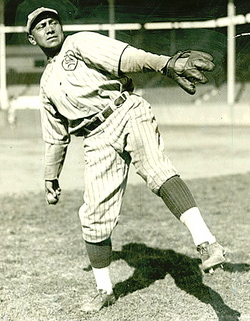Upcoming Movie about Arkansas Traveler Legend / Native American MLB Pioneer Mose YellowHorse
Posted: April 4, 2015 Filed under: Baseball | Tags: Arkansas Travelers, Indians in MLB, Mose Yellow Horse, Mose YellowHorse, Native Americans in Baseball, Pittsburgh Pirates Leave a commentA film production company has optioned the rights to a screenplay about Mose J. YellowHorse, a star on the Arkansas Travelers’ first championship team and the first full-blooded Native American in the MLB. Enid, Okla.-based River Rock Entertainment will work with screenwriters Todd Fuller and his wife on developing the script after their first draft is finished, according to Fuller.
YellowHorse was not the first Native American in the big leagues, nor the best, but was certainly one of the most colorful. As a child growing up Pawnee, Okla., he performed as a child in the Pawnee Bill Wild West Show and, according to the story of his relative, Albin LeadingFox, learned how to throw a baseball by hunting rabbits and birds with rocks. His fastball became elite.
In 1920, he led the Arkansas Travelers, then in the Southern Association, to their first league championship. The team went 21-7 and included included Joe Guyon, who in football had starred in the Carlisle Indian Industrial School’s backfield with Jim Thorpe and Bing Miller, who went on to post a .316 lifetime batting average in sixteen major league seasons, according to Fuller’s “60 Feet Six Inches and Other Distances from Home: The (Baseball) Life of Mose YellowHorse.” The screenplay will be an adaption of this book.
YellowHorse then spent a couple of seasons in Pittsburgh, where his roaring fastball and gregarious personality made him a kind of cult figure for decades afterward. His final career tally was eight wins, four losses and 3.93 ERA in 126 innings, but his most memorable stat might have been a purposefully mis-hurled foul thrown at Ty Cobb, one of the greatest players of the early 20th century.
Fuller relays the story from an interview he conducted in 1992 with one of YellowHorse’s friends:
“Ty Cobb was crowding the plate anyway, he always did. And Mose wasn’t going to let him get away with it. Cobb was up there yelling all kinds of Indian prejudice, real mean slurs at Mose, just making him mad anyway. So he shakes off four pitches until the catcher gives him the fast ball sign, and Mose nods his head. I mean everyone in Detroit was whooping and all that silliness. So he winds up and fires the ball as hard as he could, and he knocked Cobb right in the head, right between the eyes. Mose knocked him cold. And a fight nearly broke out at home plate. All the Tigers’ players came rushing off the bench. The Pirate players started running toward Mose. But no punches were thrown. They just carried Ty Cobb off the field. And all three of the Pirates’ outfielders just stood together in center and laughed. Said they wished they could see it again.”
The incident is notable as a reversal of the common narrative often framing the relations of Indians and Anglo-Americans in this era. Here, it is a full-blooded Pawnee “who holds the weapon (a ninety-five mile-an-hour fastball) and inflicts harm,” Fuller writes. It’s also significant YellowHorse’s teammates eagerly enter a fracas to protect him, suggesting a loyalty and camaraderie that would prove so instrumental in the Brooklyn Dodgers’ success with Jackie Robinson a quarter century later.
When reading this, I couldn’t help but think of the similarities here between YellowHorses’ actions and those of one of the “Jackie Robinsons of the NBA” – Arkansas native Nat “Sweetwater” Clifton. In the early 1950s. Clifton had no quibbles about flattening those who would spew racist vile at him. Instead of throwing baseballs, though, the 6-7 center threw enormous fists at the faces of offenders.
The rest of YellowHorse’s life is one of sadness (alcohol addiction) but ultimate redemption found in his homeland. His story, like those of other minority baseball pioneers, is an important one. Godspeed to those who would make a movie about it.
I’ll leave with the following poem intro. The scene is Pittsburgh, 1921, in the moments before Moses’ major league debut:
What it Means to Wear #50 (for the Pittsburgh Pirates)
This moment begins in the dim light
Of a locker room, and Mose Yellow-
Horse struggling against his uniformButtons. It’s just y’r nerves the boys
Tell him, but he knows it’s butterflies
And the sparkle of Opening Day.Soon enough he’ll take in the field,
The crowd of twenty-five thousand,
See mustard dripping from the chins
Of enchanted fathers.This will be the first time they’ve seen
An Indian in Pittsburgh. And some
Whoop and holler; mumble & inquire.Some will cheer. They watch the Reds
And Pirates battle deep into the tussle;
Nip and tuck from the start.It’s April 21, and Mose YellowHorse
Doesn’t know that kids are peeking
Through cracks in the outfield wall…
Read the rest of this Todd Fuller poem here.
Arkansas Travelers’ “Otey the Swamp Possum” As Gateway Mascot to Toothless Meth Head-ism
Posted: March 26, 2014 Filed under: Baseball | Tags: Arkansas Travelers, horrified young adults, new mascot, old mascot, potentially disturbed young children Leave a commentThere have been quite a few famous faces affiliated with the Arkansas Travelers since the minor league baseball franchise was formed in 1901. Hall of Famers Tris Speaker, Travis Jackson, Bill Dickey, Jim Bunning, Ferguson Jenkins – along with Angels superstar Mike Trout – top the list.
No roster addition, however, has caused as big a stir as the Travelers’ latest – Otey the Swamp Possum. The new mascot, designed by a California-based company and introduced this week, is meant to pay homage to one of the best second basemen in Traveler history* while appealing to children. So far, though, it has primarily sparked a firestorm of criticism.
One fan on social media sarcastically asked why a “toothless meth head” wasn’t used instead, since “were [sic] stereotyping Arkansas.” Others asked if the possum has to look as if it was “straight out of Deliverance” and wondered the possum was used only because “negotiations to get Cooter from the Dukes of Hazzard fell through.”
Other fans are cool with the choice.
There’s more than new mascots and brand new logos to be excited/enraged about heading into the season. Here’s a preview, courtesy of Tiffany White:
In April this year, the Travelers – under an all-new coaching staff – will enter their 14th season as an affiliate of the Los Angeles Angels and 48th in the Texas League. The schedule for the 2014 season includes the Texas League All-Star Game, one of the highlights of the season, to be played at Dickey-Stephens Park on Tuesday, June 24. It is the first time that it is played at the team’s new field – the Dickey-Stephens Field, in North Little Rock – which opened in 2007 replacing the former Ray Winder Field (named after Ray Winder who worked as ticket taker in 1915 before rising to general manager) which had served the Travelers since 1932.
The opening of the new season might be the right opportunity to place your bets on the baseball teams playing in the League. If you need some assistance when shopping for the right place and safest website, you might as well check the Internet for bettingsports.com sportsbook comparison. During this new season, you will have plenty of games to choose from, as the format of the Texas League season remains unchanged with the Travs playing mainly against their North Division opponents.
Their most familiar ones are The Springfield Cardinals and Tulsa Drillers (Colorado Rockies), while there are 28 games scheduled with the in-state Northwest Arkansas Naturals. Moreover, the Travs will play all South Division teams (Midland, defending champion San Antonio, Frisco and Corpus Christi) 12 times each.
They will host their eighth Home Opener at Dickey-Stephens Park on April 10th against the Midland RockHounds (Oakland Athletics). During Memorial Day weekend, the Travs will host San Antonio for a 5:30 pm game that will coincide with the Riverfest Fireworks show afterwards, while on the Fourth of July the team is hosting the Frisco RoughRiders (Texas Rangers) at 5:30 pm with the Independence Day downtown fireworks show after the game.
If you are a Travelers fan, an inveterate swamp possum mascot aficionado, and/or simply want to enjoy a good game, remember that tickets and smart packs for the 2014 season are now on sale.
* The original Otey was R.C. Otey, who died at age 88 in 2011. A graduate of North Little Rock High School, Otey broke into pro baseball in 1942 with Amarillo, but was quickly nabbed for military service. “After three years in the Navy, including eight months on Okinawa, he met and married the love of his life, Ida Maxine Morton, who eventually was the director over the Arkansas State Board of Nursing and Superintendent of Missouri Pacific Hospital,” according to his obituary. “In 1949, the Arkansas Travelers bought Infielder Otey off the Pampa Club of the Class C West Texas-New Mexico League. He was the only player who had been with one Southern club for 10 consecutive seasons. He held many records in his tenure, including the most double plays by a second baseman. In 1958, Otey retired from playing baseball and became the Ray Winder Park Superintendent, a position he held for almost 30 years.” – via arkbaseball.com
The year before Otey retired, the Little Rock Travelers were named after the entire state and became the Arkansas Travelers. Throughout the years, they have been part of eight Major League farm Systems. After going through a dry decade for league titles, when Arkansas never climbed higher than second but still attracted 250,000 fans annually, they started to win again in 2001, when the new millennium and a new Major League affiliation with the Angels brought another Texas League title.



